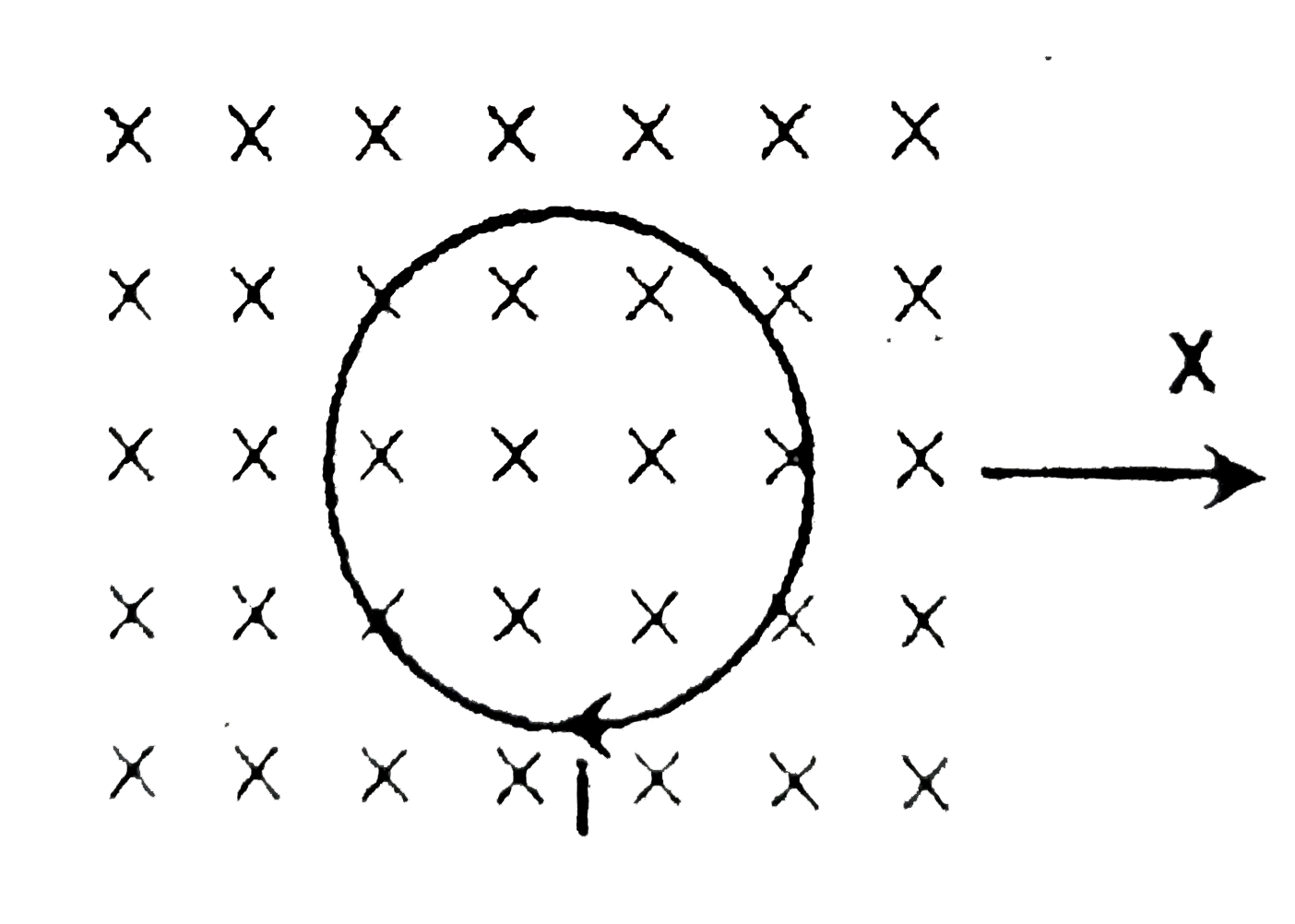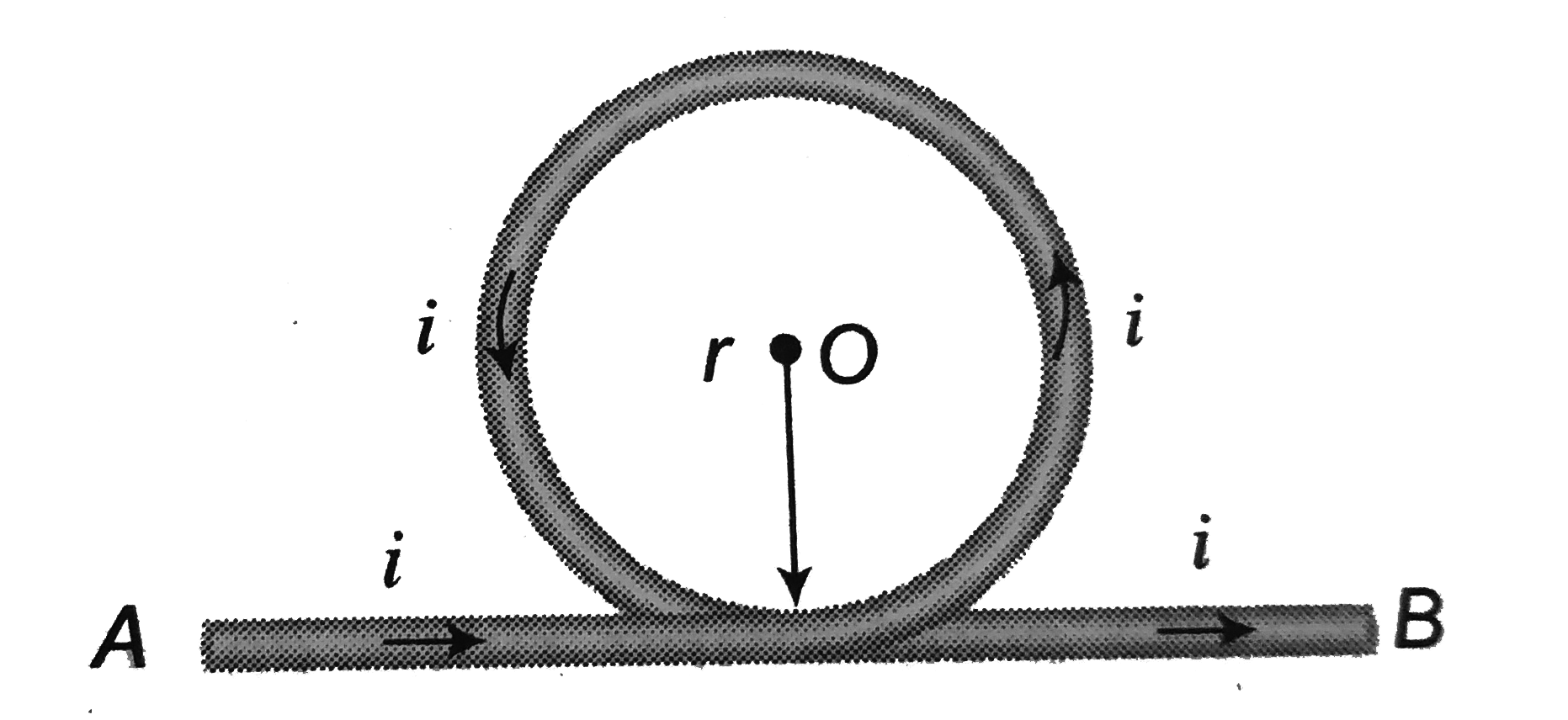A circular loop of radius r carrying a current i is held at the centre of another circular loop of radius R(>> r) carrying a current I. The plane of the smaller loop makes an angle of 30∘ with that of the larger loop. It the smaller loop is held fixed in this position by applying a single force at a point on its periphery, what would be the minimum magnitude of this force?
To solve the problem, we need to find the minimum force required to keep a smaller circular loop fixed in the presence of a magnetic field produced by a larger circular loop. Here’s a step-by-step solution:
Step 1: Understand the Configuration
We have two circular loops:
- A smaller loop of radius r carrying a current i.
- A larger loop of radius R (where R≫r) carrying a current I.
The plane of the smaller loop makes an angle of 30∘ with the plane of the larger loop.
Step 2: Determine the Magnetic Moment of the Smaller Loop
The magnetic moment μ of the smaller loop is given by:
μ=i⋅A
where A is the area of the smaller loop. The area A of a circular loop is:
A=πr2
Thus, the magnetic moment becomes:
μ=i⋅πr2
Step 3: Calculate the Magnetic Field at the Center of the Larger Loop
The magnetic field B at the center of the larger loop is given by:
B=μ0I2R
where μ0 is the permeability of free space.
Step 4: Determine the Torque Acting on the Smaller Loop
The torque τ acting on the smaller loop due to the magnetic field is given by:
τ=μ⋅B⋅sin(θ)
where θ is the angle between the magnetic moment and the magnetic field. Since the smaller loop makes an angle of 30∘ with the plane of the larger loop, the angle between the magnetic moment and the magnetic field is:
θ=90∘+30∘=120∘
Thus, we have:
τ=μ⋅B⋅sin(120∘)
Step 5: Substitute Values into the Torque Equation
Substituting the expressions for μ and B:
τ=(i⋅πr2)⋅(μ0I2R)⋅sin(120∘)
We know that sin(120∘)=√32, so:
τ=(i⋅πr2⋅μ0I2R)⋅√32
Step 6: Set Up the Equation for the Force
The torque due to the applied force F at the periphery of the smaller loop is given by:
τ=F⋅r
Setting the two expressions for torque equal gives:
F⋅r=(i⋅πr2⋅μ0I2R⋅√32)
Step 7: Solve for the Force F
Rearranging the equation to solve for F:
F=i⋅πr⋅μ0I⋅√322R
This simplifies to:
F=μ0iI⋅πr⋅√34R
Final Answer
The minimum magnitude of the force required to keep the smaller loop fixed is:
F=μ0iI⋅πr⋅√34R
We have two circular loops:
- A smaller loop of radius r carrying a current i.
- A larger loop of radius R (where R≫r) carrying a current I.
The plane of the smaller loop makes an angle of 30∘ with the plane of the larger loop.
The magnetic moment μ of the smaller loop is given by:
μ=i⋅A
where A is the area of the smaller loop. The area A of a circular loop is:
A=πr2
Thus, the magnetic moment becomes:
μ=i⋅πr2
The magnetic field B at the center of the larger loop is given by:
B=μ0I2R
where μ0 is the permeability of free space.
The torque τ acting on the smaller loop due to the magnetic field is given by:
τ=μ⋅B⋅sin(θ)
where θ is the angle between the magnetic moment and the magnetic field. Since the smaller loop makes an angle of 30∘ with the plane of the larger loop, the angle between the magnetic moment and the magnetic field is:
θ=90∘+30∘=120∘
Thus, we have:
τ=μ⋅B⋅sin(120∘)
Substituting the expressions for μ and B:
τ=(i⋅πr2)⋅(μ0I2R)⋅sin(120∘)
We know that sin(120∘)=√32, so:
τ=(i⋅πr2⋅μ0I2R)⋅√32
The torque due to the applied force F at the periphery of the smaller loop is given by:
τ=F⋅r
Setting the two expressions for torque equal gives:
F⋅r=(i⋅πr2⋅μ0I2R⋅√32)
Rearranging the equation to solve for F:
F=i⋅πr⋅μ0I⋅√322R
This simplifies to:
F=μ0iI⋅πr⋅√34R
The minimum magnitude of the force required to keep the smaller loop fixed is:
F=μ0iI⋅πr⋅√34R
Topper's Solved these Questions
- MAGNETIC FIELD DUE TO CURRENTBook:HC VERMA ENGLISHChapter:MAGNETIC FIELD DUE TO CURRENTExercise:questions for short answer
Explore 12 Videos
- MAGNETIC FIELD DUE TO CURRENTBook:HC VERMA ENGLISHChapter:MAGNETIC FIELD DUE TO CURRENTExercise:Objective 2
Explore 7 Videos
- MAGNETIC FIELDBook:HC VERMA ENGLISHChapter:MAGNETIC FIELDExercise:objective2
Explore 9 Videos
- MAGNETIC PROPERTIES OF MATTERBook:HC VERMA ENGLISHChapter:MAGNETIC PROPERTIES OF MATTERExercise:Short Answer
Explore 6 Videos
Similar Questions
A circular loop of radius R carries a current I. Another circular loop of radius r(ltltR) carries a current I. The plane of the smaller loop makes an angle of 90^@ with that of the larger loop. The planes of the two circles are at right angle to each other. Find the torque acting on the smaller loop.
View SolutionMagnetic field at the centre of a circualr loop of area A carrying current I is B. What is the magnetic moment of this loop?
View Solution
Knowledge Check
Magnetic field at the centre of a circualr loop of area A carrying current I is B. What is the magnetic moment of this loop?
A(BA)2μ0πBBA√Aμ0CBA√Aμ0πD2BA√Aμ0√π
A square loop of side a carris a current I. The magnetic field at the centre of the loop is
View SolutionWhat will be magnetic field at centre of current carrying circular loop of radius R?
View SolutionA circular loop carrying a current is replaced by an equivalent magnetic dipole. A point on the axis of the loop is in
View SolutionA circular loop of radius r carries a current i. where should a long , straight wire carrying a current 4i be placed in the plane of the circle so that the magnetic field at the centre becomes zero?
View SolutionA circular loop of wire is carring a current i (as shown in the figure). On applying a uniform magnetic field inward perpendicular to the plane of the loop, the loop

View SolutionA part of a long wire carrying a current i is bent into a circle of radius r as shown in figure. The net magnetic field at the centre O of the circular loop is

View SolutionA part of a long wire carrying a current i is bent into a circle of radius r as shown in figure. The net magnetic field at the centre O of the circular loop is :

View Solution
